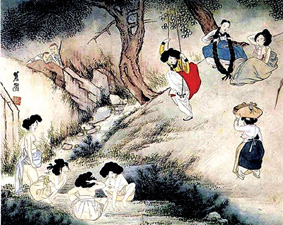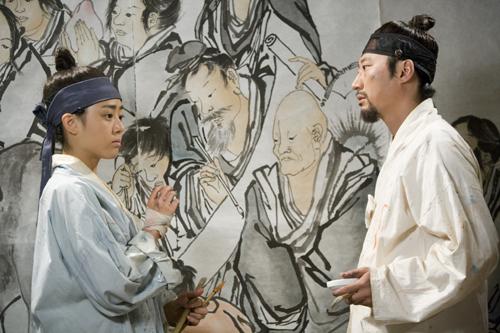
Professor Lee Jong-mok (Korean Painting) received a phone call from the drama production team of Seoul Broadcasting System (SBS) in February earlier this year. The team requested Lee to help them make a television drama about two legendary artists of the late Joseon period, Kim Hong-do and Shin Yun-bok. The drama script started with an interesting assumption that Shin Yun-bok was actually a female painter who pretended to be a man. "At first, I was hesitant to participate since "Painter of Wind" had assumptions that might be different from historical facts. But I decided to participate, believing that this may be an opportunity to help the public understand Korean paintings properly," said Lee.
Lee soon formed a "Dream team" of three painters: Ahn Kook-ju ('95, Korean Painting), Baek Jee-hye ('98, Korean Painting), and Koo Se-jin ('07, Korean Painting). The task given to the team was reproducing the famous works of Kim Hong-do and Shin Yun-bok, such as Kunsundo, Danopoongjung, Me-indo (paintings below from left to right), preparing several other paintings that appear in the drama and providing advice related to the traditional Korean paintings.
The team has currently painted about 150 paintings that have been appearing in the drama one by one. Lee says making a replica in traditional Korean painting means more than just copying the original pieces. "The process of making the replica was arduous and difficult. The act of copying in traditional Korean painting means facing the mind and heart of the painter who drew the original copy. The replicas in the drama could only be drawn after sharing feelings with the painters who drew the masterpieces," said Lee.
Students worked day and night to produce the exact replicas. "We often drew at the studio set with the actors. In case of Kunsundo, we had to draw about 50 rough copies to produce the final, perfect one," said Ahn.
"For the pictures drawn on silk, we also drew on silk," said Lee. This helped in raising the reality level of the drama. Moreover, the members extracted colors from stones, soils, and other natural dyes to retrieve the colors actually used by the painters of Joseon. "Interestingly, more kinds of colors were used those days than today," said Lee.
Lee also helped out in teaching the main characters of the drama, Park Shin-yang (starred as Kim Hong-do) and Moon Geun-young (starred as Shin Yun-bok) for three months before the shoot. Lee gave lessons for Park and Moon in order for them to draw pictures in some scenes. "Moon had a strong will to learn and got used to the techniques quickly. Park also made beautiful strokes with the brushes. I was very surprised about how he expressed Kim Hong-do very well with his acting," said Lee.

However, for some special scenes, where the whole process of completing the painting have to be shown, Lee and his team members act as the hands of the actors. Looking at the movement of the brush drawing the masterpieces is known as one of the amusements in "Painter of Wind." The brushworks of the team have made the drama more than a drama; it is a television art gallery of traditional Korean paintings for thousands of viewers. The show also brought public interest to traditional Korean paintings. About 20 thousand people visited Kansong Art Gallery from the first day of October to see the exhibition, where many paintings of Kim Hong-do and Shin Yun-bok are placed.
At the same time, what the painters gained from the production process is no less. "By copying, I could find the hidden attractiveness of the art pieces, which I did not know just by looking at it. I was surprised and enjoyed every moment of the work," said Ahn. "The picture portrayed a ceremony held in the Joseon Dynasty with 1000 people drawn in detail. I found out that everyone actually had different facial expressions while drawing. I could feel the sense of humor of the Joseon painters," said Koo. "Iam proud that our team is learning a lot from the project and what we have drawn is seen by many viewers. I hope the traditional Korean paintings impress them," said Lee. The copies done by Lee's team will be shown in "Painter of Wind" continuously until its end.


